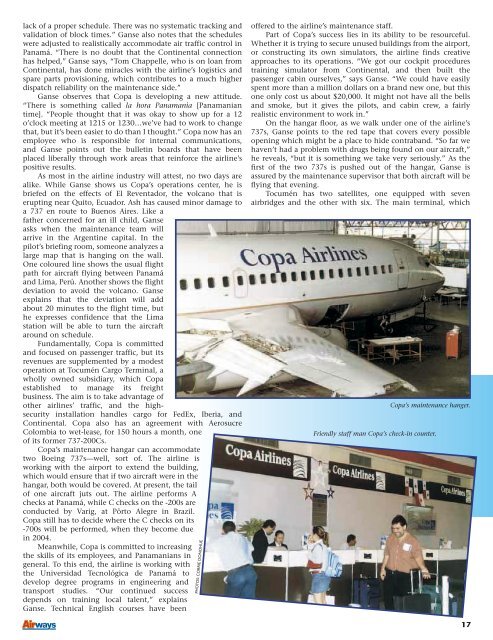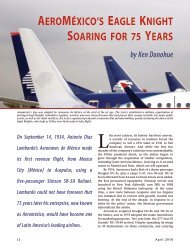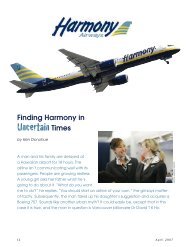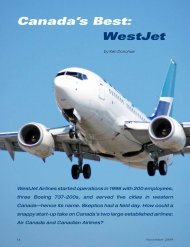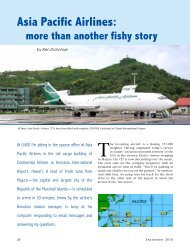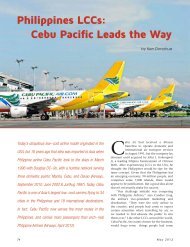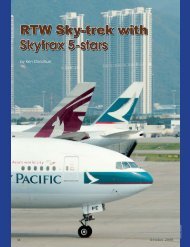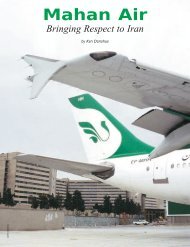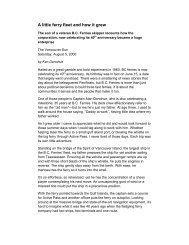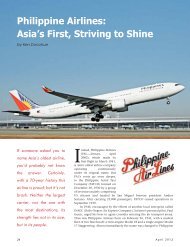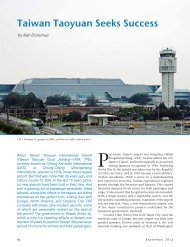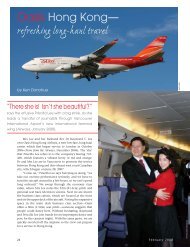Copa Airlines - Ken Donohue
Copa Airlines - Ken Donohue
Copa Airlines - Ken Donohue
You also want an ePaper? Increase the reach of your titles
YUMPU automatically turns print PDFs into web optimized ePapers that Google loves.
lack of a proper schedule. There was no systematic tracking and<br />
validation of block times.” Ganse also notes that the schedules<br />
were adjusted to realistically accommodate air traffic control in<br />
Panamá. “There is no doubt that the Continental connection<br />
has helped,” Ganse says, “Tom Chappelle, who is on loan from<br />
Continental, has done miracles with the airline’s logistics and<br />
spare parts provisioning, which contributes to a much higher<br />
dispatch reliability on the maintenance side.”<br />
Ganse observes that <strong>Copa</strong> is developing a new attitude.<br />
“There is something called la hora Panamania [Panamanian<br />
time]. “People thought that it was okay to show up for a 12<br />
o’clock meeting at 1215 or 1230…we’ve had to work to change<br />
that, but it’s been easier to do than I thought.” <strong>Copa</strong> now has an<br />
employee who is responsible for internal communications,<br />
and Ganse points out the bulletin boards that have been<br />
placed liberally through work areas that reinforce the airline’s<br />
positive results.<br />
As most in the airline industry will attest, no two days are<br />
alike. While Ganse shows us <strong>Copa</strong>’s operations center, he is<br />
briefed on the effects of El Reventador, the volcano that is<br />
erupting near Quito, Ecuador. Ash has caused minor damage to<br />
a 737 en route to Buenos Aires. Like a<br />
father concerned for an ill child, Ganse<br />
asks when the maintenance team will<br />
arrive in the Argentine capital. In the<br />
pilot’s briefing room, someone analyzes a<br />
large map that is hanging on the wall.<br />
One coloured line shows the usual flight<br />
path for aircraft flying between Panamá<br />
and Lima, Perú. Another shows the flight<br />
deviation to avoid the volcano. Ganse<br />
explains that the deviation will add<br />
about 20 minutes to the flight time, but<br />
he expresses confidence that the Lima<br />
station will be able to turn the aircraft<br />
around on schedule.<br />
Fundamentally, <strong>Copa</strong> is committed<br />
and focused on passenger traffic, but its<br />
revenues are supplemented by a modest<br />
operation at Tocumén Cargo Terminal, a<br />
wholly owned subsidiary, which <strong>Copa</strong><br />
established to manage its freight<br />
business. The aim is to take advantage of<br />
other airlines’ traffic, and the highsecurity<br />
installation handles cargo for FedEx, Iberia, and<br />
Continental. <strong>Copa</strong> also has an agreement with Aerosucre<br />
Colombia to wet-lease, for 150 hours a month, one<br />
of its former 737-200Cs.<br />
<strong>Copa</strong>’s maintenance hangar can accommodate<br />
two Boeing 737s—well, sort of. The airline is<br />
working with the airport to extend the building,<br />
which would ensure that if two aircraft were in the<br />
hangar, both would be covered. At present, the tail<br />
of one aircraft juts out. The airline performs A<br />
checks at Panamá, while C checks on the -200s are<br />
conducted by Varig, at Pôrto Alegre in Brazil.<br />
<strong>Copa</strong> still has to decide where the C checks on its<br />
-700s will be performed, when they become due<br />
in 2004.<br />
Meanwhile, <strong>Copa</strong> is committed to increasing<br />
the skills of its employees, and Panamanians in<br />
general. To this end, the airline is working with<br />
the Universidad Tecnológica de Panamá to<br />
develop degree programs in engineering and<br />
transport studies. “Our continued success<br />
depends on training local talent,” explains<br />
Ganse. Technical English courses have been<br />
PHOTOS: CORRIE DONOHUE<br />
offered to the airline’s maintenance staff.<br />
Part of <strong>Copa</strong>’s success lies in its ability to be resourceful.<br />
Whether it is trying to secure unused buildings from the airport,<br />
or constructing its own simulators, the airline finds creative<br />
approaches to its operations. “We got our cockpit procedures<br />
training simulator from Continental, and then built the<br />
passenger cabin ourselves,” says Ganse. “We could have easily<br />
spent more than a million dollars on a brand new one, but this<br />
one only cost us about $20,000. It might not have all the bells<br />
and smoke, but it gives the pilots, and cabin crew, a fairly<br />
realistic environment to work in.”<br />
On the hangar floor, as we walk under one of the airline’s<br />
737s, Ganse points to the red tape that covers every possible<br />
opening which might be a place to hide contraband. “So far we<br />
haven’t had a problem with drugs being found on our aircraft,”<br />
he reveals, “but it is something we take very seriously.” As the<br />
first of the two 737s is pushed out of the hangar, Ganse is<br />
assured by the maintenance supervisor that both aircraft will be<br />
flying that evening.<br />
Tocumén has two satellites, one equipped with seven<br />
airbridges and the other with six. The main terminal, which<br />
<strong>Copa</strong>’s maintenance hanger.<br />
Friendly staff man <strong>Copa</strong>’s check-in counter.<br />
17


